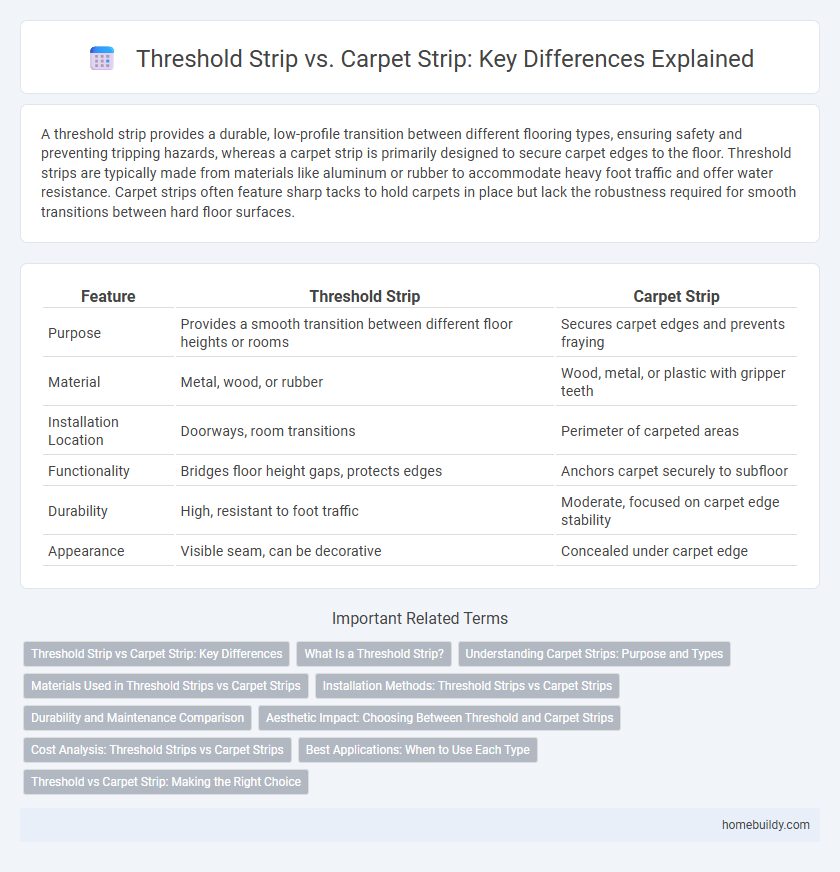A threshold strip provides a durable, low-profile transition between different flooring types, ensuring safety and preventing tripping hazards, whereas a carpet strip is primarily designed to secure carpet edges to the floor. Threshold strips are typically made from materials like aluminum or rubber to accommodate heavy foot traffic and offer water resistance. Carpet strips often feature sharp tacks to hold carpets in place but lack the robustness required for smooth transitions between hard floor surfaces.
Table of Comparison
| Feature | Threshold Strip | Carpet Strip |
|---|---|---|
| Purpose | Provides a smooth transition between different floor heights or rooms | Secures carpet edges and prevents fraying |
| Material | Metal, wood, or rubber | Wood, metal, or plastic with gripper teeth |
| Installation Location | Doorways, room transitions | Perimeter of carpeted areas |
| Functionality | Bridges floor height gaps, protects edges | Anchors carpet securely to subfloor |
| Durability | High, resistant to foot traffic | Moderate, focused on carpet edge stability |
| Appearance | Visible seam, can be decorative | Concealed under carpet edge |
Threshold Strip vs Carpet Strip: Key Differences
Threshold strips are designed to bridge gaps between different flooring types, providing a smooth transition and enhancing safety by preventing trips. Carpet strips, also known as carpet tack strips, are specifically used to secure carpet edges to the floor, ensuring a tight and durable installation. Unlike carpet strips, threshold strips accommodate a variety of materials such as tile, hardwood, and laminate, making them more versatile for threshold applications.
What Is a Threshold Strip?
A threshold strip is a durable strip installed at doorways to bridge gaps between different flooring types, providing a smooth transition and preventing tripping hazards. Unlike a carpet strip, which primarily secures carpet edges by gripping the backing with sharp nails, threshold strips are often made of metal, wood, or vinyl and are designed to protect flooring edges and accommodate foot traffic. These strips enhance the aesthetic continuity between rooms while offering functional benefits such as moisture resistance and floor leveling.
Understanding Carpet Strips: Purpose and Types
Carpet strips serve as the essential foundation for securing carpet edges, preventing unraveling and ensuring a smooth transition between flooring types. These strips come in various types, including tackless strips with angled nails to grip carpet backing, and metal or vinyl variants designed for durability. Understanding the purpose and specific types of carpet strips allows for proper installation and enhanced carpet longevity compared to threshold strips, which primarily bridge gaps between different floor surfaces.
Materials Used in Threshold Strips vs Carpet Strips
Threshold strips are typically made from durable materials such as aluminum, brass, wood, or vinyl to withstand high traffic and provide a smooth transition between flooring surfaces. Carpet strips, on the other hand, usually utilize wood or MDF (medium-density fiberboard) with metal grippers to securely hold carpet edges in place. The choice of materials directly influences durability and functionality, with threshold strips favoring harder metals and plastics for resilience, while carpet strips prioritize grip and flexibility for carpet installation.
Installation Methods: Threshold Strips vs Carpet Strips
Threshold strips are typically installed using screws or adhesive directly onto the subfloor, providing a secure and stable transition between different flooring types. Carpet strips, on the other hand, rely on tack strips nailed along the edges of the floor to hold the carpet in place by gripping its backing. The installation of threshold strips generally requires drilling and proper alignment, while carpet strips involve positioning the tack strip accurately and stretching the carpet for a snug fit.
Durability and Maintenance Comparison
Threshold strips typically offer greater durability than carpet strips due to their construction from materials like aluminum, rubber, or hardwood, which resist wear and moisture effectively. Carpet strips, often made of softer materials such as vinyl or flexible plastics designed to anchor carpet edges, can wear down more quickly and may require more frequent replacement or repair. Maintenance for threshold strips is generally easier, requiring only occasional cleaning and minimal upkeep, whereas carpet strips may accumulate dirt and suffer damage from foot traffic, necessitating more regular attention.
Aesthetic Impact: Choosing Between Threshold and Carpet Strips
Threshold strips offer a sleek, minimalistic aesthetic that seamlessly blends with flooring transitions, enhancing the overall visual appeal of doorways. Carpet strips, often bulkier, create a more pronounced separation that can disrupt the flow of a room's design and may appear less refined. Selecting threshold strips prioritizes a clean, modern look, while carpet strips cater to practicality but may compromise aesthetic cohesion.
Cost Analysis: Threshold Strips vs Carpet Strips
Threshold strips typically offer a more cost-effective solution compared to carpet strips due to their durable materials and ease of installation, reducing labor expenses. Carpet strips often require frequent replacement and additional adhesives, increasing long-term maintenance costs. Evaluating upfront cost against lifespan and maintenance highlights threshold strips as a budget-friendly option for door transitions.
Best Applications: When to Use Each Type
Threshold strips are ideal for bridging gaps between different floor types, such as hardwood and tile, to provide a smooth transition and protect edges from damage in high-traffic areas. Carpet strips are specifically designed for securing carpeting edges to prevent fraying and create a snug fit, making them best suited for carpet installations in residential or commercial spaces. Choose threshold strips for durability and versatile flooring transitions, while carpet strips are preferred for maintaining carpet integrity and aesthetics.
Threshold vs Carpet Strip: Making the Right Choice
Threshold strips provide a durable, elevation-adjusting solution for doorways, ensuring smooth transitions between different flooring types, while carpet strips primarily secure carpet edges without addressing height differences. Choosing between threshold strips and carpet strips depends on the flooring transition requirements, with threshold strips ideal for areas needing gap coverage and height adjustment, and carpet strips better suited for fastening carpet edges securely to prevent fraying. Proper selection enhances flooring longevity and safety by addressing specific installation and functional needs.
threshold strip vs carpet strip Infographic

 homebuildy.com
homebuildy.com